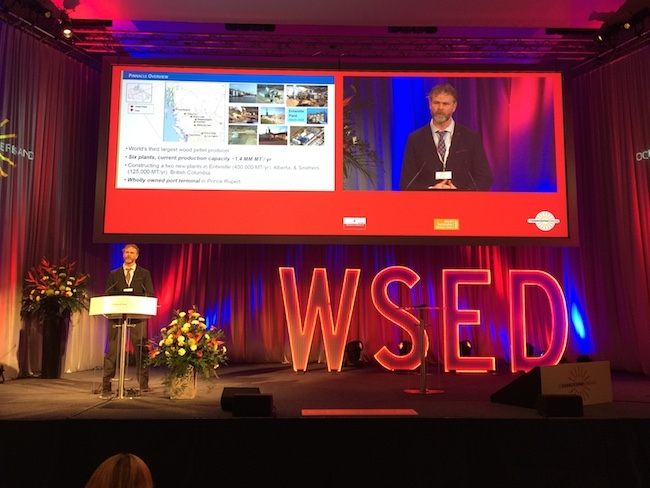
Takeaways from the 2018 European Pellet Conference
May 9, 2018
By Gord Murray WPAC executive director
May 9, 2018 - The annual European Pellet Conference (EPC) took place in Wels, Austria from February 27 to March 1, 2018. Scott Bax of Pinnacle Renewable Energy, John Arsenault, WPAC’s Director of Market Access and Promotion, and I participated. The EPC is one of the largest annual global wood pellet events with about 560 participants. The event focusses mainly on the commercial and residential applications for wood pellets. Speakers and participants come from Europe, North America, South America, Asia, Africa and Australia.
 Scott Bax of Pinnacle Renewable Energy presents at the 2018 European Pellet Conference in Wels
Scott Bax of Pinnacle Renewable Energy presents at the 2018 European Pellet Conference in Wels On February 27 we joined a field trip to wood pellet and wood chip heating and gasification sites: (1) We visited the home ÖkoFEN founder Herbert Ortner where we saw his combined wood pellet condensing boiler-sterling engine-solar panel-battery system, which provides 100 per cent of Mr. Ortner’s home heat, domestic electricity, and electric vehicle charging. Mr. Ortner’s home is not reliant on external electrical or gas grids; (2) We toured the ultra-modern ÖkoFEN wood pellet boiler factory; (3) We visited Froling, one of Europe’s largest biomass boiler manufacturers. Froling makes log-wood, chip, and pellet boilers. Notably, Froling produces a combined heat and power (CHP) system that incorporates a fixed-fed gasifier. Their system produces syngas which fuels a combustion engine to produce electricity and heat. Froling has installed 130 such CHP systems; (4) A commercial facility using multiple Froling CHP systems in tandem to provide electricity for sale to the grid and to generate heat for drying grain; and (5) a municipal district heating system using multiple Hargassner wood chip boiler connected in tandem to heat municipal buildings and private homes.
The conference sessions took place on February 28 and March 1. A variety of topics were covered on February 27 while the March 1 session was focussed on reports from individual country representatives on the situations in their own home markets. Scott Bax gave a presentation on safety operations in wood pellet plants; Gordon Murray was the moderator for the session Pellet News Worldwide.
Key conference takeaways included:
• Dr. Ute Collier of the International Energy Agency reported on the IEA’s Bioenergy Roadmap. Bioenergy is expected to account for 17 per cent of all energy by 2060, up from 4.5 per cent today. Strong acceleration of bioenergy deployment is needed. Presently 80 per cent of renewable heat in Europe comes from bioenergy.
• Nathalie Hemelers of the European Bioenergy Association gave an overview of the EU’s Clean Energy Package, which will set the regulatory framework for the period 2020 to 2030. Specifics of the Clean Energy Package are currently being negotiated in a trilogue between the European Union, the European Commission, and the European Council.
• Jan Steinbach of the Fraunhofer Institute reviewed research on mapping the European heating sector. He expects that the future of residential pellet combustion can rely on fuel flexibility, high efficiency operation at condensing mode and almost zero emissions. These features will support the further market penetration of pellet combustion plants and increase the public acceptance as well as market share for the new technology.
• Dr. Ingwald Obernberger presented research on how the design of small-scale pellet boilers can be improved to increase their competitiveness on the residential-scale heating market by increasing fuel flexibility, further reducing emissions and the integration of advanced flue gas condensers to increase efficiency.
• Maura Adams of the U.S. Northern Forest Center described the NFC’s Lets make pellets cool again initiative which is intended to educate the public about automated wood pellet heating systems.
• Windhager’s Manfried Faustman emphasized the important role that boiler installers as being the front-line representatives for our industry. Often installers are the ones who recommend which systems to use. The quality of boiler installations will affect word-of-mouth communication that can have a huge influence on the success of the biomass boiler market.
• Lukas Kranzl of the Technical University Vienna, Austria, discussed the potential for coupling heat pumps with wood pellet boilers to improve heating system economics.
• Kay Staubach of DBFZ presented the Global Wood Pellet Industry and Trade Study. The EU accounts for 75 per cent of global consumption and 54 per cent of production of which 64 per cent of pellets are used for heat generation and 36 per cent are used for electricity. North America accounts for 12 per cent of global consumption – almost entirely for heat – and 35 per cent of global production. Japan and South Korea are rising, while China remains a large unknown.
• Stan Elliott of the Pellet Fuels Institute reported that exports account for about 80 per cent of the 6.9 million tonnes of U.S. pellet production. U.S. domestic pellet consumption is stagnant as a result of competition with low heating oil costs, repeated warm winters, lack of government incentives, and poor technology. He said, “The vast majority of pellet appliances being offered are still black box room heaters.”
• Martin Bentele of DEPV (the German Pellet Institute) and Christian Rakos of proPellets Austria reported on their two countries, which are wood pellet powerhouses. Germany is producing 2.3 million tonnes annually while consuming 2.2 million tonnes. Austria is producing 1.3 million tonnes and consuming 1.0 million tonnes. Both countries are dominated by highly automated wood pellet boiler systems as opposed to pellet stoves.
The European Pellet Conference is a great place to become informed about the latest European and international biomass policy developments and how they are likely to affect future business strategy; learn about new technology; and to get first-hand information on worldwide wood pellet market conditions. With more than 500 participants, it is an ideal opportunity to connect with customers, competitors, and suppliers, and to promote Canada as a reliable source of high-quality, sustainably produced wood pellets.
Print this page